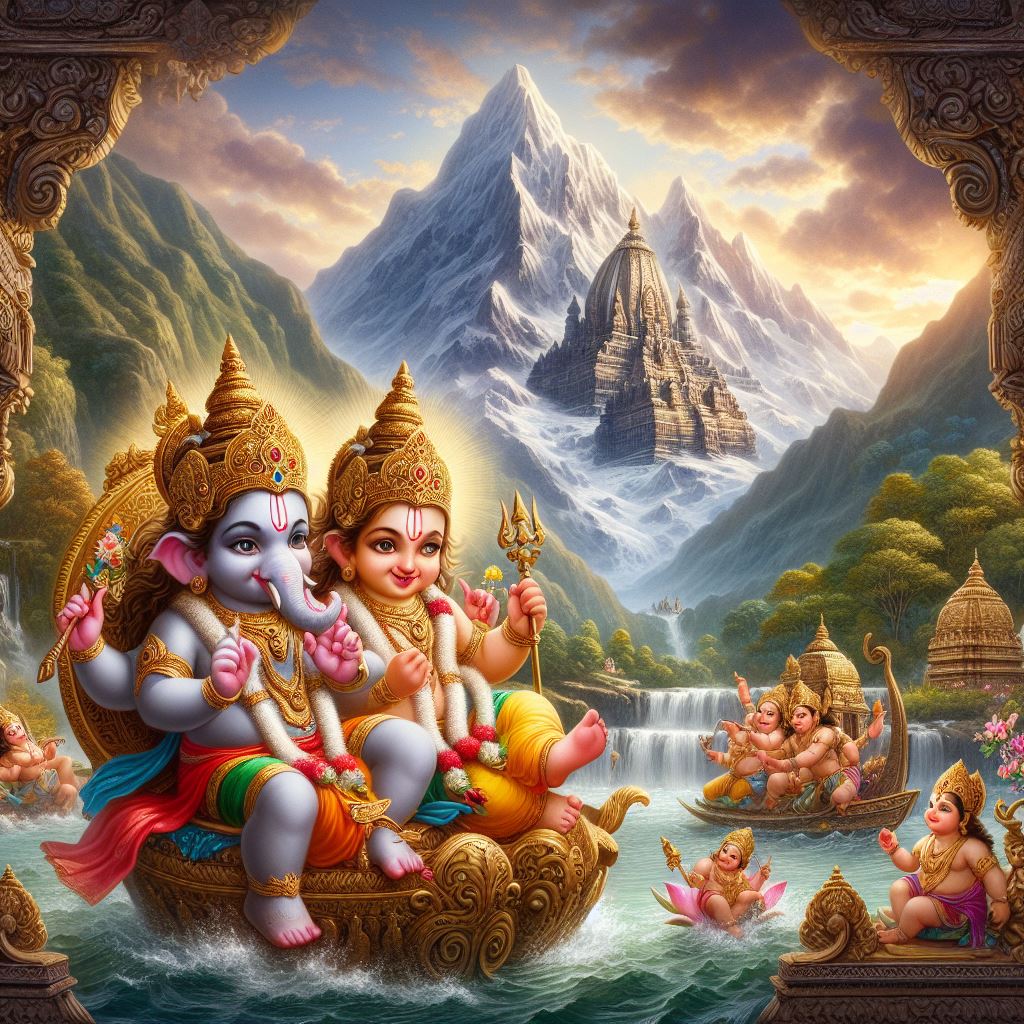Hinduism: Beyond Mythology, Embracing itihāsa
Introduction:
Hinduism, often misunderstood as a collection of myths and legends, transcends conventional definitions of mythology. At its core, Hinduism is rooted in Itihasa, meaning “history” or “thus indeed it was.” Unlike myths, which typically connote fictional narratives, the stories within Hindu scriptures are perceived as events that transpired on various planes of existence, including the celestial realm. This essay aims to elucidate why Hinduism cannot be confined within the constraints of mythology, drawing upon its rich tradition of Itihasa and the profound implications it carries.
Understanding Mythology:
Before delving into the essence of Hinduism as Itihasa, it is imperative to grasp the conventional understanding of mythology. According to the dictionary, a myth is a traditional story, especially one concerning the early history of a people or explaining natural or social phenomena, typically involving supernatural beings or events. Mythology, therefore, refers to the collection or study of such myths.
Myths are often characterized by their allegorical nature, serving as symbolic narratives that convey cultural beliefs, values, and explanations for various phenomena. These narratives may involve gods, heroes, and supernatural entities, but they are not necessarily considered literal accounts of historical events. Instead, myths are understood as symbolic representations of human experiences, archetypes, and the collective unconscious of a culture.
Hinduism and Itihasa:
Contrary to the conventional notion of mythology, Hinduism encompasses a vast array of scriptures, including the Vedas, Upanishads, Puranas, and epics like the Ramayana and Mahabharata. While these texts contain narratives involving gods, sages, and celestial beings, they are not merely myths but are regarded as Itihasa, meaning “thus indeed it was” or “history.”
The distinction between mythology and Itihasa lies in the perception of these narratives within Hindu philosophy. Rather than being interpreted solely as symbolic allegories, the events described in Hindu scriptures are believed to have occurred in the past, albeit on different planes of existence. In Hindu cosmology, the universe comprises multiple Lokas or realms, including the earthly realm (Bhuloka) and celestial realms (Swargaloka), where divine beings reside.
The stories within Hindu scriptures are understood as accounts of real events that occurred in these various realms, shaping the course of cosmic history. For example, the Ramayana narrates the life and adventures of Lord Rama, depicting his divine incarnation and his journey to rescue his wife Sita from the demon king Ravana. Similarly, the Mahabharata chronicles the epic conflict between the Pandavas and Kauravas, reflecting the cosmic struggle between dharma (righteousness) and adharma (unrighteousness).
The Realism of Hindu Narratives:
What sets Hindu narratives apart from conventional myths is their profound realism and moral depth. While they may involve supernatural elements and divine interventions, the characters and events portrayed in these narratives are deeply relatable and resonate with human experiences. The heroes and heroines of Hindu epics face moral dilemmas, ethical challenges, and existential crises, mirroring the complexities of human existence.
Moreover, the teachings embedded within these narratives offer timeless wisdom and guidance for navigating the complexities of life. Whether it is Lord Krishna’s discourse on duty and righteousness in the Bhagavad Gita or Lord Rama’s unwavering commitment to truth and virtue in the Ramayana, Hindu scriptures serve as repositories of moral and spiritual knowledge.
Hinduism as a conglomeration of three things → Eternal/unchanging truths, ancient lore, and histories of current or recent Yuga-s. The Puranas are also not myths, they are in fact the histories happened in remote past, or in other realms. The etymology of ‘Purana’ says, “purāneti navaṃ iti purāṇaṃ“, meaning, “Though the lore is ancient yet it sounds to be new hence it is called ‘purana’“. This definition itself indicates that what is Purana for us today, was itihasa of some past times. All these stories put together have only one aim, i.e., the aim of teaching us the means to the fourfold pursuits (catuṣphala puruśārtha-s) – there is nothing that falls outside of this fourfold framework!
In none of those three categories does exist any room for something to be a ‘myth’. A myth could be ‘hare’s horns’ or ‘Santa clause’, but Gods, their interventions, miracles, mystical powers, divine weapons, Yogic prowess etc., nothing is impossible to be achieved or realized in Hinduism. Therefore, where the possibilities are itself endless, where is the room for anything being mythical?
There are phenomena that happen inside us, there are events that happen in cosmic plane, and there are events that happen on Earthly plane as well. So, the plane may vary making some narratives alien to our land and technology of our times, thus making them sound too wonderful to be believed. And these are the narratives which make some people who remain unable to comprehend the meaning, to term them myths.
Furthermore, archaeological and historical evidence corroborates many aspects of Hindu narratives, suggesting that they may indeed be rooted in historical events. For instance, recent archaeological discoveries have unearthed ancient cities and artifacts associated with the Mahabharata, providing tangible evidence of its historical basis.
Beyond Literalism: Allegory and Symbolism in Hinduism:
While Hinduism embraces the historical reality of its narratives, it also recognizes the deeper layers of allegory and symbolism embedded within them. The characters and events in Hindu scriptures often represent abstract concepts, psychological archetypes, and cosmic principles. For example, we see Brahma manifesting Saraswati from himself and then marrying her. To the uninitiated mind it would look gross and unacceptable thinking them as father and daughter, but these stories have allegory inside which when learnt, they wouldn’t sound ridiculous anymore.
The power of Knowledge when existed within Brahma, she was his Shakti, when the same Shakti was projected outside, how would she become a daughter? She still remains his own inherent power but visible outside in the form of a Goddess. Secondly, the earthly relationships are not valid in celestial plane because any divine entity that gets projected from one’s being is termed as his/her son or daughter, as it came from him/her.
But that shouldn’t be taken as literal son/daughter as per our world’s definition. It’s the divine being’s inner potency which manifested in visible form, that’s all. So, in such instances the terms used as ‘daughter’ etc., are metaphorical for the world of mortals to comprehend the concepts better but that doesn’t make Brahma as Saraswati’s father and their relationship as couple as unrighteous.
Similarly, the Ramayana and Mahabharata are replete with symbolic motifs and allegorical interpretations that transcend their literal meanings. These narratives serve as mirrors to the human psyche, reflecting universal themes of love, sacrifice, duty, and transcendence.
Conclusion:
In conclusion, Hinduism defies categorization within the conventional framework of mythology. Rather than being mere myths, Hindu scriptures are regarded as Itihasa, signifying their historical reality and profound significance. While acknowledging the realism of these narratives, Hinduism also embraces the allegorical and symbolic dimensions inherent within them, inviting seekers to explore deeper truths and insights.
By recognizing the distinction between mythology and Itihasa, we gain a deeper appreciation for the richness and complexity of Hindu philosophy and spirituality. In a world often characterized by dichotomies between fact and fiction, science and spirituality, Hinduism offers a holistic worldview that transcends such dualities, inviting us to explore the interconnectedness of the material and spiritual dimensions of existence.
FAQ-s
This article addresses the below FAQ-s:
- Why Hinduism is not Hindu Mythology?
- Why is Hinduism not mythology?
- What is Hinduism?
- What is Sanatana Dharma?



